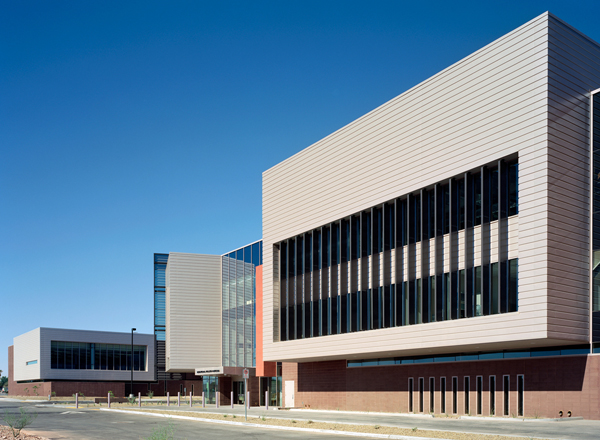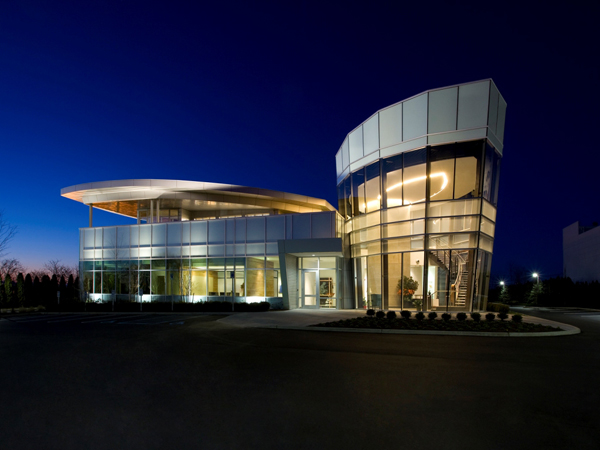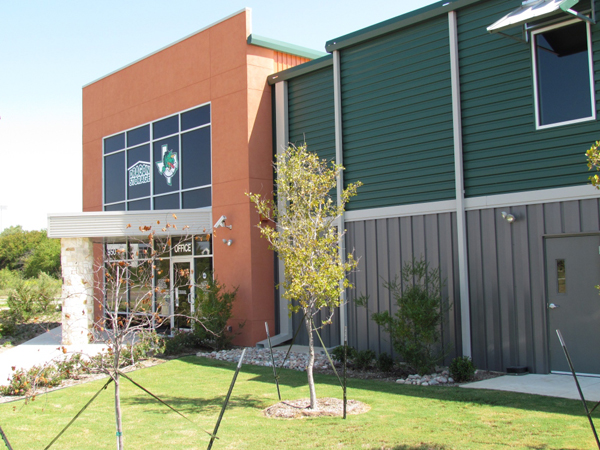The Many Advantages Of Metal Wall Panels
By MCA's Wall Panel Council: Jim Tuschall, Michael Beck and David Killian
It's no wonder metal walls are popular in both commercial and residential construction. They offer a multitude of design capabilities and a sustainable barrier to weather. While most often utilized in commercial office, educational and manufacturing buildings,
metal wall panels also have unique uses in residential homes and condos.
Aesthetics. Metal panels create a beautiful appearance for exterior and interior applications. Shiny and matte finishes can be shaped into a wide array of patterns, to look ultra-modern or vintage.
Fireproofing. While fire is always a risk in any building, metal walls can act as a barrier to fire to help keep an active fire from spreading and the affected area cool during intense heat.
Rain Screen. Metal panels act as a rain screen and barrier, keeping water from entering a building and spreading from room to room. In rainy climates, metal barriers can prevent mold and decay of other building materials.
Energy Savings. Metal's density saves energy, lowering expenses for building owners. Metal walls are eco-friendly and meet building regulations for sustainable materials. Carbon footprints and stresses on the earth’s resources are
reduced.
Durability. Metal walls hold up extremely well to daily wear and tear, with hardness varying slightly depending on the type of metal. These panels do not dent or ding easily. They maintain their beauty for years.
Low Installation and Maintenance Costs. In most cases, metal wall panels can be installed more quickly than brick, granite, precast and other materials. They're typically lighter, requiring less support structure.
Design Flexibility. Metal walls make it easy for architects and interior designers to meet their unique design specifications. An extensive selection of colors, textures and designs can be adapted for most commercial and residential projects.
Now let's examine the three main types of metal wall panels:
 |
The University of Arizona Behavioral Health Pavilion + Crisis Response Center In Tucson, AZ, features insulated metal wall panels from Kingspan Insulated Panels, and rainscreen cladding products from CENTRIA. Both manufacturers are MCA
member companies. |
IMPs
Insulated Metal Panels (IMPs) are lightweight composite exterior wall and roof panels with metal skins and an insulating foam core. IMPs have superior insulating properties. Their outstanding spanning capabilities and one-pass installation make them quick
and inexpensive to install compared to other wall assemblies.
IMPs come in a wide variety of colors, widths, profiles and finishes, enabling virtually any aesthetic. They make an excellent choice for:
Commercial and Industrial. IMPs are ideal for all types of commercial and industrial buildings—institutional, recreational, governmental or manufacturing. Everything from schools to retail centers to power plants benefit from the unique energy-efficient
insulation, lightweight construction, durability, and cost-effective, timely installation of single component IMPs. Temperature, humidity, airborne particles and air movement are among the climatic considerations IMPs address.
Architectural. These IMPs offer the attributes of other commercial and industrial segments—high insulation values, speed of build, vertical and horizontal applications—plus options such as custom shapes and widths, special custom colors
and finishes, bent corners and other custom fabrication, curved panels, and trimless ends. These panels integrate beautifully with windows, louvers, sunshades and other products for total building envelope solutions. They free up architects to design
striking, one-of-a-kind buildings.
Cold Storage. IMPs are the ultimate solution for nearly any climate-controlled facility— manufacturing, processing, storage, or distribution of perishable food or other temperature-sensitive materials. With panels available in thicknesses
from 3-6 inches, a wall can be designed to meet specific thermal performance requirements. Additional features include long spanning capability, flat and ribbed shaped panels, high-performance coatings, and special joint designs and details to meet
hygiene and contamination control requirements.
For an IMP kit and other IMP resources, click here.
 |
The Rechler Office Building in Plainview, NY, features insulated metal wall panels from CENTRIA and aluminum composite metal wall panels fabricated from ALPOLIC ACM from Mitsubishi Plastics Composites America Inc. Both companies
are MCA members. |
MCM Panels
Metal Composite Material (MCM) wall panel systems have been used in North American construction projects for nearly 40 years. The product was originally called aluminum composite materials (ACM). The name changed to metal composite materials (MCM) to
reflect the introduction of zinc, copper, stainless steel, titanium and other new skin metals, although aluminum remains the predominant skin material.
Panels are formed by bonding two metal skins to a highly engineered plastic core between them. The bonding process occurs under precise conditions of temperature, pressure and tension. The result is a metal/plastic composite with far greater benefits
than a solid metal sheet of similar thickness. For design flexibility, MCM sheets come in various lengths and widths.
MCMs combine aesthetics and affordability. Building owners and architects looking to make a design statement can count on today's MCMs for their exterior cladding. Formable into various shapes, these wall systems can impart a high-tech look that dramatically
sets the building apart.
The smooth, sleek metal composite material can be bent, curved and joined in practically any geometric configuration. The panels give off a gorgeous glow when newly installed and retain their luster for years with minimal maintenance.
Consistency in Flatness and Finish. When it comes to consistency and precision, MCM systems are among the best products the metal construction industry has to offer. Case studies repeatedly show how MCMs stay flat after installation. There's no
"oil canning" or wrinkling because the skins are bonded to the core under tension for a balanced panel.
Aluminum and steel MCMs can be finished in nearly any color. New developments in paint application technology keep the finish consistent from one panel to the next, eliminating checkerboarding on the building's exterior. Zinc, copper and titanium panels
are usually installed unfinished to make the most of their natural properties.
Cost-Competitive. While MCM systems used to be limited to high-end projects, improvements in product technology, manufacturing efficiencies, and fabrication and installation techniques make them more cost-competitive than ever.
Multi-Functional. MCMs are now being installed on various building types and applications ranging from major project wall panel systems to cornices and canopies. They're frequently used to join areas between other building materials such as glass and precast panels.
Lower Installation & Maintenance Costs. Initial construction costs are often lower with MCM systems because the panels can typically be installed faster than precast, granite, brick or other exteriors. Light in weight, MCM systems require less
support, thus lowering structural steel requirements.
Advances in paints and coatings further reduce maintenance costs. MCMs retain their luster for decades, helping maintain aesthetic appeal and property value. Buildings retain their curb
appeal without looking dated or needing pre-sale refurbishing.
Building Envelope Protection. MCM systems provide a building envelope that resists the elements, protecting against air and water infiltration. Installation systems can virtually eliminate mold and mildew. MCMs are an environmentally responsible
and sustainable choice. About 70% of an MCM by weight is recycled content.
For case studies, suppliers, technical resources and more, visit
http://www.metalconstruction.org/Metal_Composite_Materials#outline.
 |
Dragon Storage in Southlake, TX features a variety of single-skin metal panel products from MBCI, an MCA member company. |
Single Skin Metal Panels
Preformed, or roll-formed, metal wall panels have served building owners and architects as one of the best combinations of economy, service and design. Recent manufacturing improvements have yielded a wider selection of profiles. While breakthroughs in
coating technology are prolonging panel life, new design options have launched metal wall panels into the mainstream of commercial building design.
Panel Longevity. Preformed metal wall panels are manufactured from steel, aluminum, copper, zinc and other metals. Steel panels can be made with a highly durable paint or coating to protect them from the elements—one reason why it remains
the most commonly used metal in commercial construction.
The finishes are applied during manufacturing in a controlled environment to help ensure greater
protection and longevity. Preformed metal wall panels come insulated or uninsulated. Insulated metal panel systems are generally comprised of an exterior panel and an interior liner panel.
Owners can look forward to a metal wall panel service life of 20-30 years or more depending on geographic location and environmental conditions. Highly durable metal coatings contribute to longevity and low maintenance.
Low Installed Cost. Preformed metal wall panels cost less installed than tilt-up, precast or brick and are comparable to synthetic stucco or EIFS. These panels can often be installed faster than other wall materials and reduce construction costs.
Installation isn't slowed by weather conditions, minimizing construction delays. These panels allow for fast-track scheduling, getting the building dried-in sooner, and for other trades to proceed with interior work.
Ecofriendly. Metal wall panels are environmentally sensible and sustainable. They're comprised of high recycled content and are 100% recyclable at the end of their useful life.
High Level of Design Freedom. Preformed or roll-formed metal wall panels have been used almost exclusively on industrial plants and warehouses. Today, they work for just about every type of structure, from manufacturing facilities and stores
to schools and office buildings. Their popularity, especially in the commercial market, is due in part to their versatility. They can now be installed horizontally as well as vertically. A variety of unique looks and curved panels lend even more shape
to wall designs.
Colors, Textures and Profiles Galore. Today's preformed metal wall panels offer more choices than ever. The more popular profiles include batten, integral batten, corrugated, and stepped. These help create distinctive reveals, shadow lines and
other architectural effects. Textures range from smooth to stucco-like, with colors from standard hues to custom-matched.
The myriad design options can add distinctive architectural effects without incurring much additional expense. Economic feasibility combined with time-proven performance make preformed metal wall panels a great choice for exterior wall applications.
For case studies, suppliers and other resources, visit http://www.metalconstruction.org/Single_Skin_Panels#outline
About The Metal Construction Association
 Founded
in 1983, MCA represents over 100 member companies that manufacture and
distribute products for the metal construction industry. The
association’s mission is to promote the use of metal in the building
envelope. Member volunteers collaborate on projects to educate
contractors and architects about best practices for metal design and
installation, while also ensuring compliance with evolving building
codes and standards that support safety, sustainability, and
performance. Companies involved in MCA benefit greatly from activities
focused on research, codes and standards, market development, and
technical programs. For more information, visit www.metalconstruction.org.
Founded
in 1983, MCA represents over 100 member companies that manufacture and
distribute products for the metal construction industry. The
association’s mission is to promote the use of metal in the building
envelope. Member volunteers collaborate on projects to educate
contractors and architects about best practices for metal design and
installation, while also ensuring compliance with evolving building
codes and standards that support safety, sustainability, and
performance. Companies involved in MCA benefit greatly from activities
focused on research, codes and standards, market development, and
technical programs. For more information, visit www.metalconstruction.org.



